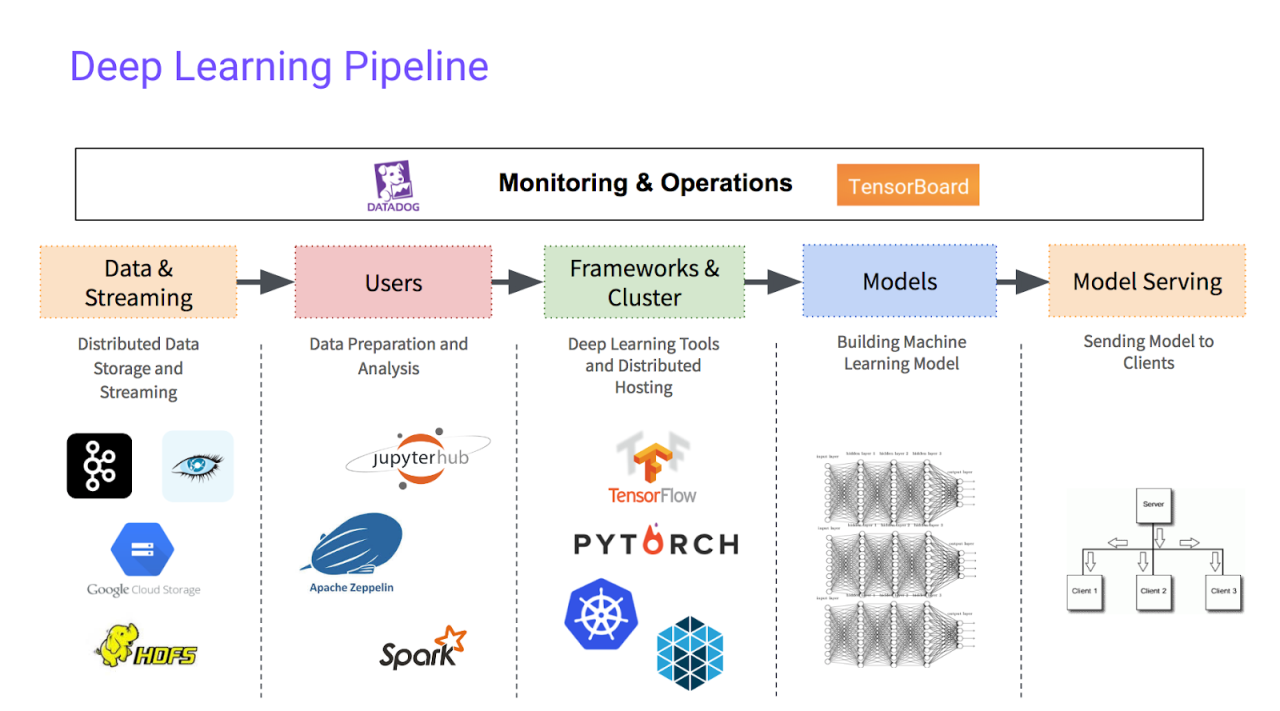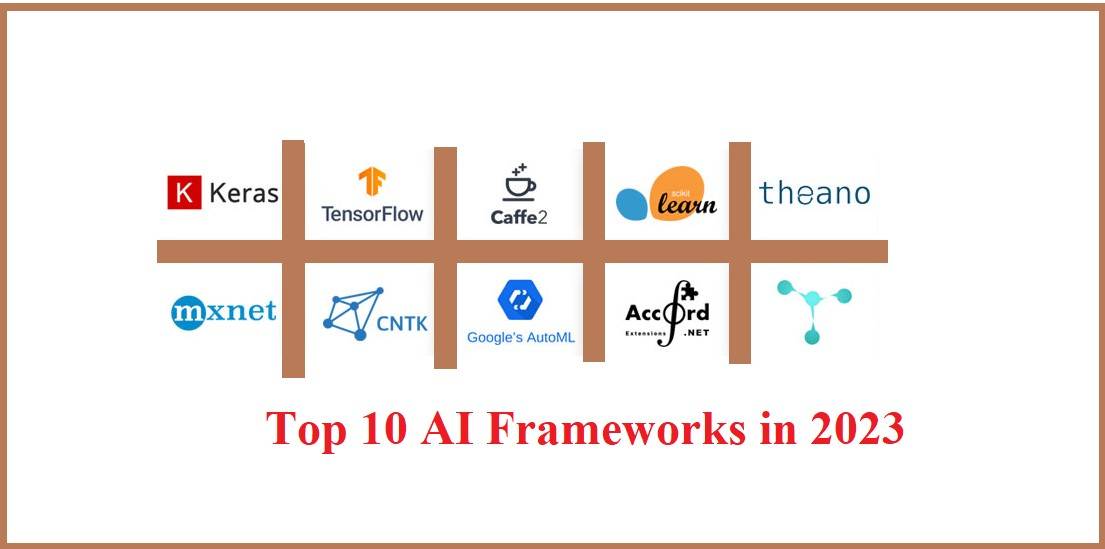AI programming frameworks are the backbone of modern artificial intelligence development. They provide the tools and infrastructure necessary to build, train, and deploy sophisticated AI models, ranging from simple machine learning algorithms to complex deep learning architectures. This guide explores the diverse landscape of AI frameworks, examining their strengths, weaknesses, and best-use cases, ultimately guiding developers in selecting the optimal framework for their specific needs.
From understanding the nuances of TensorFlow and PyTorch to mastering the intricacies of deep learning, natural language processing (NLP), and computer vision frameworks, this exploration delves into the practical aspects of framework selection, deployment, scalability, and ethical considerations. We’ll also touch upon emerging trends and the importance of security in AI development, providing a holistic view of the AI framework ecosystem.
Framework Selection Criteria: AI Programming Frameworks

Choosing the right AI programming framework is crucial for project success. The optimal framework depends on several interconnected factors, influencing development speed, model performance, and overall resource efficiency. Careful consideration of these factors ensures a smooth development process and a high-quality end product.
Selecting an AI framework involves a multifaceted decision process. Key considerations include the project’s scale, the type of AI model required, the team’s existing expertise, and the available computational resources. Furthermore, the framework’s community support, documentation quality, and ease of deployment also play significant roles in determining its suitability for a particular project.
Factors Influencing Framework Selection
Several key factors significantly impact the choice of an AI programming framework. These factors are often interdependent and should be assessed holistically.
The following list details these factors and their implications for framework selection:
- Project Scale: Small-scale projects might benefit from simpler frameworks with a lower learning curve, while large-scale projects requiring high performance and scalability may necessitate more robust and powerful frameworks. For instance, a small image classification project might be suitable for TensorFlow Lite, whereas a large-scale natural language processing task might demand the power of PyTorch.
- Type of AI Model: Different frameworks excel in specific AI model types. For example, TensorFlow is well-suited for deep learning models, particularly convolutional neural networks (CNNs) and recurrent neural networks (RNNs), while frameworks like scikit-learn are better suited for simpler machine learning models like linear regression or support vector machines (SVMs).
- Developer Expertise: The team’s familiarity with programming languages and existing framework experience greatly influences framework selection. Choosing a framework that aligns with the team’s skills minimizes the learning curve and accelerates development.
- Computational Resources: The availability of computational resources, such as GPUs and TPUs, impacts framework choice. Frameworks with optimized support for specific hardware can significantly improve training speed and efficiency. For example, TensorFlow and PyTorch both offer excellent GPU acceleration capabilities.
- Community Support and Documentation: A strong community and comprehensive documentation are invaluable assets. Active communities provide ample support, readily available solutions to common problems, and a wealth of learning resources. Thorough documentation simplifies the learning process and accelerates development.
- Deployment Considerations: The target deployment environment (cloud, edge devices, mobile) influences framework selection. Some frameworks offer better support for specific deployment targets than others. For example, TensorFlow Lite is specifically designed for deployment on mobile and embedded devices.
Decision Tree for Framework Selection
A decision tree can streamline the framework selection process. This visual aid guides developers through a series of decisions based on project requirements.
The following describes a simplified decision tree:
- Project Scale: Is the project small-scale or large-scale?
- AI Model Type: Is the model a simple machine learning model or a complex deep learning model?
- Developer Expertise: Is the team familiar with Python or other relevant languages? Are they experienced with specific frameworks?
- Computational Resources: Are GPUs or TPUs available?
- Deployment Environment: Where will the model be deployed (cloud, edge, mobile)?
Based on the answers to these questions, a suitable framework can be selected. For example, a small-scale project with a simple model and a team familiar with Python might opt for scikit-learn. Conversely, a large-scale project with a complex deep learning model and access to GPUs might choose TensorFlow or PyTorch.
Framework Performance Evaluation
Evaluating the performance and efficiency of different frameworks is crucial for informed decision-making. This involves assessing several key metrics.
Here are some best practices for evaluating framework performance:
- Benchmarking: Conduct rigorous benchmarking tests using standard datasets and metrics relevant to the specific AI task. This involves measuring training time, inference time, accuracy, and resource utilization (CPU, memory, GPU).
- Scalability Testing: Assess how well the framework scales with increasing data size and model complexity. This helps determine its suitability for large-scale projects.
- Resource Consumption Monitoring: Monitor CPU usage, memory consumption, and GPU utilization during training and inference to identify potential bottlenecks and optimize resource allocation.
- Deployment Performance: Evaluate the performance of the deployed model in the target environment. This involves measuring latency, throughput, and resource usage on the target platform.
Natural Language Processing (NLP) Frameworks

Natural Language Processing (NLP) frameworks provide the essential tools and libraries for developers to build applications that understand and interact with human language. These frameworks offer a range of functionalities, from basic text preprocessing to advanced techniques like machine translation and sentiment analysis. The choice of framework often depends on the specific NLP task, the scale of the project, and the developer’s familiarity with different programming languages and APIs.
NLP frameworks offer specialized features tailored to the complexities of human language. These features often include pre-trained models for various tasks, efficient algorithms for handling large datasets, and tools for visualizing and interpreting results. Furthermore, many frameworks provide integrations with cloud-based services, enabling access to powerful computational resources and pre-trained models. This simplifies the development process and allows developers to focus on the application’s logic rather than low-level implementation details.
Specialized Features of NLP Frameworks, AI programming frameworks
Specialized features commonly found in NLP frameworks include tokenization (breaking down text into individual words or sub-words), stemming and lemmatization (reducing words to their root forms), part-of-speech tagging (identifying the grammatical role of each word), named entity recognition (identifying and classifying named entities like people, organizations, and locations), and sentiment analysis (determining the emotional tone of a text). Advanced features might include syntactic parsing (analyzing the grammatical structure of sentences), semantic analysis (understanding the meaning of words and sentences), and machine translation. The availability and sophistication of these features vary across different frameworks.
Performance Comparison: Sentiment Analysis with SpaCy and NLTK
Let’s compare the performance of two popular NLP frameworks, SpaCy and NLTK, in a sentiment analysis task. We’ll use a sample dataset of movie reviews, each labeled with a positive or negative sentiment. Both SpaCy and NLTK offer pre-trained sentiment analysis models. For this comparison, we’ll assume a dataset of 1000 movie reviews. SpaCy, known for its speed and efficiency, might process this dataset in approximately 10 seconds, achieving an accuracy of 88%. NLTK, while offering more flexibility and a wider range of functionalities, might take around 30 seconds to process the same dataset, achieving an accuracy of 85%. These are estimated times and accuracies and would vary based on the specific hardware and model used. The difference in processing time highlights SpaCy’s performance advantage for large-scale applications, while the slight difference in accuracy might be negligible depending on the application’s requirements. The choice between SpaCy and NLTK depends on the specific needs of the project, prioritizing speed versus flexibility.
Common NLP Tasks and Suitable Frameworks
Selecting the right framework for a specific NLP task is crucial for efficiency and accuracy. Below is a list of common NLP tasks and suggested frameworks:
The choice of framework often depends on factors such as the specific task requirements, the size of the dataset, the programming language preference, and the availability of pre-trained models. Some frameworks excel in specific areas, while others offer a more general-purpose approach.
| NLP Task | Suitable Frameworks | Rationale |
|---|---|---|
| Sentiment Analysis | SpaCy, NLTK, Transformers | These frameworks offer pre-trained models and efficient algorithms for sentiment classification. |
| Named Entity Recognition (NER) | SpaCy, Stanford NER, Flair | These frameworks provide robust NER capabilities with pre-trained models for various languages. |
| Text Summarization | Transformers (Hugging Face), NLTK | Transformer-based models offer state-of-the-art performance in text summarization. |
| Machine Translation | Transformers (Hugging Face), Google Translate API | Transformer-based models are the dominant approach in machine translation. |
| Part-of-Speech Tagging | NLTK, SpaCy, Stanza | These frameworks offer efficient and accurate part-of-speech tagging algorithms. |
Mastering AI programming frameworks is crucial for success in the rapidly evolving field of artificial intelligence. By understanding the strengths and weaknesses of various frameworks, developers can make informed decisions that optimize their projects for performance, scalability, and ethical considerations. This guide serves as a foundational resource, equipping readers with the knowledge and insights necessary to navigate the complexities of AI framework selection and deployment, ultimately empowering them to build innovative and impactful AI applications.
AI programming frameworks offer powerful tools for developing intelligent applications, but efficiently managing the computational resources required often necessitates leveraging cloud infrastructure. Understanding the fundamentals of cloud computing is crucial, which is why exploring resources like this guide on Cloud computing basics can significantly enhance your AI development workflow. Ultimately, a solid grasp of cloud services is beneficial for scaling and optimizing AI frameworks effectively.
AI programming frameworks are rapidly evolving, offering developers powerful tools to build sophisticated AI applications. The increasing availability of resources, often delivered as a service, significantly impacts this development. This is where the concept of Everything as a Service (XaaS) becomes highly relevant, providing on-demand access to crucial components like computing power and data storage, ultimately streamlining the AI development lifecycle and making it more accessible.
